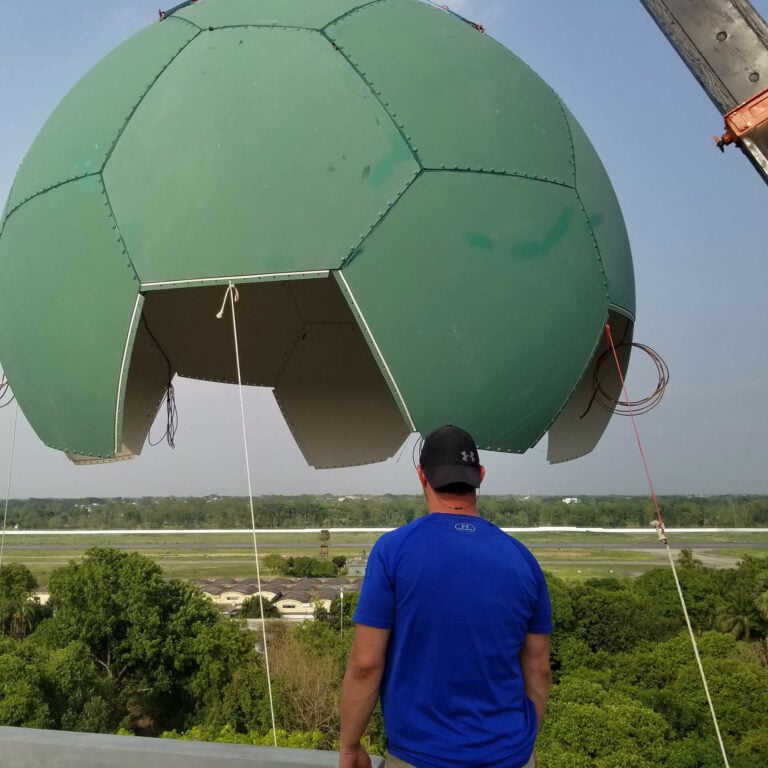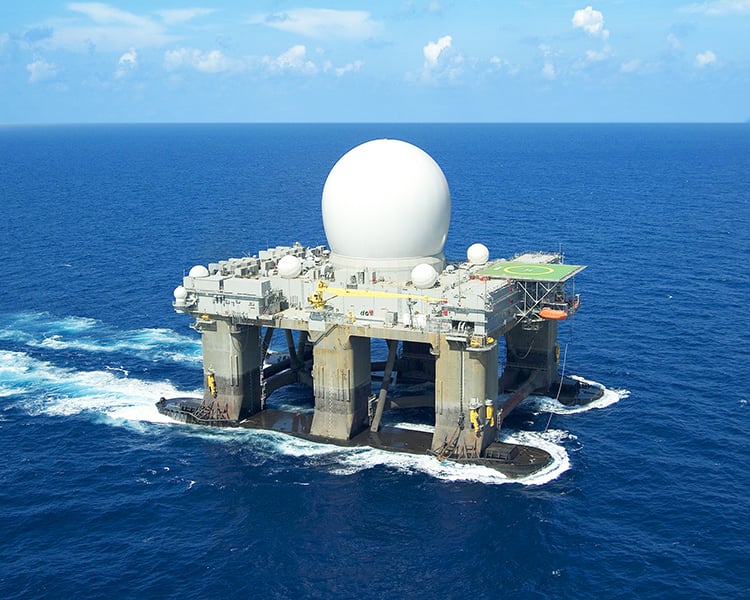A weather radar is a critical tool for meteorology agencies to enhance weather monitoring and forecasting or issue warnings when severe weather events occur. One of the most remarkable aspects of radar is its ability to "see" beyond what we observe.
With its far-reaching capabilities, radar can detect weather patterns even miles away, giving meteorologists a head-start when issuing timely warnings for severe weather events like flooding, tornadoes, and thunderstorms. This invaluable technology allows communities to prepare and take necessary precautions, potentially saving lives.
Since radars can be an expensive component of an agency’s collective tools, it’s essential to understand the parts that make up these powerful instruments. With proper maintenance, Baron radars will operate for 10-20+ years, so it’s critical to know that this investment is ultimately a sustainable solution.
Tower
The tower is the structural foundation for the radar. The tower design, which ensures the stability of the radar, provides height to the radar to minimize localized signal or RF blockage from things like terrain, buildings, vegetation, and other items. Stability is essential when you consider that the antenna constantly rotates, changing speed and elevation. Movement or vibrations at the top of the tower will lessen data quality. While a radar antenna and its components can be mounted on top of a building, many environmental, structural, and obstruction factors must be considered.
Yet tower height must be considered as height is usually determined by how much blockage or objects are immediately around the tower and the antenna. Towers should start at a minimum of 5 meters and can be as tall as 30+ meters, but that affects costs. Baron can provide services for free-standing towers or those atop a building.
Radome

The radome is a spherical enclosure atop the tower or roof-mounted radar components. This shell must be manufactured to be larger than the antenna to ensure the antenna can move freely inside the radome. This critical component protects every element within its environment and is transparent to the radar beam. The radome is also hydrophobic, meaning it repels water because any precipitation on the radome can negatively affect the outgoing and incoming signals or electromagnetic pulses. In addition, the radome shields the antenna from wind and sun while adding years to the lifespan of the radar.
Tower Top Plate
The top plate is the platform on which the pedestal and radome are mounted atop the tower. This critical piece provides stable support and a base for maintenance. The top plate has a hatch that allows easy access to the inside of the radome for periodic maintenance or parts replacement. The platform has pre-drilled mounting holes to match the tower, pedestal, and radome.
Pedestal
/Radar_CapeCanaveral_2022.png)
The pedestal is the vertical support that supports and rotates the antenna inside the radome and is the axis for the movement of the entire antenna system. While the radome is stationary, the whole antenna, the antenna-mounted electronics, and other components behind the antenna all rotate constantly atop the pedestal.
Controller
The device that controls the antennae’s movements is called the controller. This equipment controls the motors in the pedestal for azimuth and elevation movement to enable valuable operational modes such as a volumetric scan. The controller can tilt the antennae and rotate it six times per minute or even faster. Baron designed the controller components for easy service and maintenance.
Antenna
A radar antenna transmits radio waves in a focused direction that bounces off objects in its path and receives those echoes that come back. Antennas come in multiple sizes for each band, and radar antennas are usually curved to direct a pencil-thin beam at a given frequency for maximum sensitivity and resolution. Larger antennas are required at lower frequencies (S-Band) for an equivalent gain.
A digitizer resides inside your antennae-mounted electronics or (AME). The AME converts radio frequency or electromagnetic energy into a digital signal that the processor can interpret. It’s located on the back of the antenna to minimize signal loss by eliminating the use of waveguide back down to the shelter at the bottom of the antenna, maximizing sensitivity.
Waveguide
A waveguide is a hollow conductive metal pipe that guides the radar pulses between the transmitter and the antenna feedhorn. The pulse is then transmitted to the parabolic antenna and reflected into the atmosphere. The returned pulses are then sent to the AME where the receiver/digitizer reside-returned pulses are then sent to the AME where the receiver/digitizer resides. Once the RF is digitized, it is sent to the shelter via fiber optic cable. This removes any further data loss during signal return, where it is sent for processing.
Transmitter
A Transmitter creates the electromagnetic pulses that are radiated by the radar’s antenna. The transmitter is critical because it ensures the pulse is of the highest quality, so the data coming back is also of optimal quality for processing and display. Since there is also a high-voltage power supply found within, safety devices are built to protect service personnel from electric shock.
A climate-controlled environment is required to keep moisture and temperature levels within the range necessary for maximum performance and longevity. Baron offers both Magnetron and Klystron transmitters with power outputs from 250 kilowatts to more than a million watts. Because redundant climate control is preferred to guarantee operation at all times, Baron incorporates redundant climate control in our shelter designs.
Signal Processor
The signal processor ingests the digital radar returns from the AME to produce radar data. This is where that digitized signal comes down into the shelter and is then processed to make different dual-pol movements for display and interpretation by the end user.
Of those vertical and horizontal pulses sent out to the processor is critical for analysis and early warning.
UPS
The UPS, or Uninterruptible Power Supply, temporarily provides backup power if the main power is lost. The UPS can power the radar for several minutes before a backup generator starts, guaranteeing radar operation and data production in a sudden outage or power degradation. Baron provides specs so that the correct UPS size is supplied.
Communications/Bandwidth
Today’s dual-polarity radars can provide an incredible amount of data for the end user. This data must be delivered from the radar site to the met office for display and analysis. For complete data availability for the end user, a minimum 10Mbs network connection is required. Higher bandwidth is preferred.
Radar Never Takes a Break
This technology works around the clock, continuously scanning the skies and updating meteorologists on the ever-changing weather conditions. By providing a constant stream of up-to-date information, radar helps forecasters refine their predictions, leading to more accurate and reliable forecasts. Learn more about building a better radar, radar options, clutter suppression, and other solutions Baron can provide!










